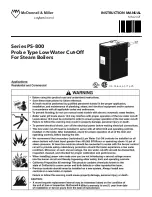
9
x
Service and maintenance
9.2.2 Checking and cleaning the condensate drain
The connection and leakage line of the condensate drain must be
free from impurities.
●
If a solaris system (DrainBack) is connected and is in
operation, switch it off and empty the collectors.
●
Check that the condensate drain is free from blockages and
clean if necessary.
●
Visual inspection of the tank fill level (fill level indicator).
●
If necessary, correct the fill level; determine the reason for the
low water level and remedy it.
●
Check the overflow hose connection and drain section for
leakage, unobstructed flow and gradient.
●
Check the condensate drain from the combustion chamber is
free (see chap. 9.2.3).
9.2.3 Checking and cleaning the burner
As a rule, the burner does not wear. Nevertheless, contamination
can occur that results in unsatisfactory combustion values and
which could obstruct the condensate drain. Therefore, the burner
must be removed (see chap. 7.4), cleaned and, if necessary,
reset (see chap. 7.3).
Cleaning the combustion chamber
●
Remove the burner (see chap. 7.4)
●
Rinse the flue gas path with clean water (hose or steam jet
device in the open combustion chamber) for at least 5
minutes. Observe during this, whether the water drains
quickly out of the combustion chamber and through the
condensate drain (see chap. 9.2.2).
Checking the burner
Checking the burner includes visually inspecting the burner's
condition as well as making flue gas measurements.
The scope of inspection includes:
●
Clean the burner surface (carefully suction the perforated
plate side if soiling is visible).
●
Visual inspection of the ignition and ionisation electrodes for
damage and correct electrode gap (see chap. 7.3.5).
WARNING!
Danger of scalding from hot storage water.
●
Before dismantling the condensate drain, allow the storage
tank to cool sufficiently.
●
Wear protective gloves.
UK only!
CAUTION!
If filling or topping up the storage tank is done by means of the
boiler filling and drain valve, a temporary filling loop must be
used with the appropriate backflow prevention device in ac-
cordance with clause G24.2, Guidance to the Water Supply
(Water Fittings) Regulations 1999.
Fig. 9-2
Check condensation water drain
The condensate is a weak acid. It is transported into the
pressureless area of the hot water storage tank. This
therefore ensures in normal system operation that the
storage tank is always filled up to the overflow edge. A
long-term neutralisation filling in the container ensures that the
fluid leaving the container has neutral pH. Any depositions
remain in the pressureless area of the container.
DANGER OF EXPLOSION!
Escaping gas is a direct threat to human health and safety. Even
a few sparks can cause major explosions.
●
Only heating specialists authorised and trained by the gas or
power supply company should be allowed to work on gas-
conducting parts.
WARNING!
Danger of burning on hot surfaces.
●
Let the burner cool down for a reasonably long time before
maintenance and service work.
●
Wear protective gloves.
Should water accumulate when rinsing the combustion
chamber and drain only slowly out, the condensate pipe
or the overfill protector in the pipe may have clogged.
To clean this area, the boiler body must be removed
from the heat cell.
For detailed information on checking and setting the
burner, see chap. 7.3.
For detailed information on installing and removing the
burner, see chap. 7.4.
Never blow over the burner surface with compressed
air. This could cause changes to the surface structure
that may initiate burner noises in the future.
In the course of maintenance work, the safety relevant
components must be additionally inspected for the
expiration of their nominal service life:
– Firing unit: 10 years or 250,000 burner starts,
– Safety gas control block: 10 years or 250,000 burner starts,
– Overpressure safety valve: 10 years.
Summary of Contents for GCU compact 315
Page 81: ...13 x Notes 13 Notes...
Page 82: ...13 x Notes...
















































